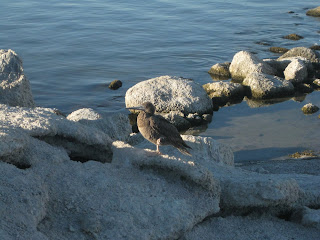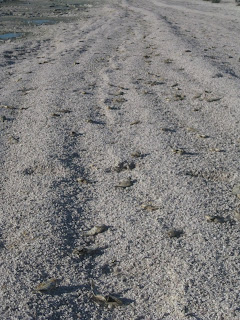We started our Thanksgiving mini-trip camping in Idyllwild in Mount San Jacinto State Park. In the morning we headed down to the desert because it was just so cold up there at 5,000 feet! We'd heard great things about the Salton Sea. When someone tells you about some smelly, stagnant lake where a bunch of the fish die off regularly and the towns around it are mostly dangerous trailer parks it doesn't sound like a place you'd ever want to go on purpose which I think is why its beauty is so refreshing. Here's where you'll find it:
View Larger Map
About 130 miles around, it's the largest lake in California and at 227 feet below sea level it's one of the lowest spots on earth. To get more information about it and its complex history check out the CA state parks page and the Salton Sea Authority page.
The quick of it is that the sea was created in 1905 when the Colorado River flooded into what was the Salton Sink. It is recognized as an important stop over for migrating birds (part of the Pacific Flyway) and breeding ground. 400 different species of migrating birds can be found here mostly during the winter and early spring. That's about half of all species of birds found in the US. According to their brochure, "Annually, as many as 1.5 million eared grebes and nearly half of California’s population of white-faced ibis have been counted at the sea." Incredible.
90% of the water inflow is from agricultural runoff which can cause problems with excessive nutrients like phosphates and nitrates. Also, partly because there is no outlet for the water, the salt content reaches extremely high levels (30% saltier than the ocean) leading to a botulism outbreak in 1996 that killed 15-20% of the western population of white pelicans and over 1,000 endangered brown pelicans. It is the largest reported die-off of an endangered species. In 1997 congressman Sonny Bono takes up the cause. In 1999, 7.6 million tilapia and croakers die from lack of oxygen in the water (due to algae). You can read about the Salton Sea Authority's plans for the sea here.
All of this is evident when you visit. There are birds everywhere and the shoreline is covered with millions of barnacle and fish and bird skeletons as well as dessicated fish from the more recent die-offs which happen periodically on a smaller scale.
Enough information. Really, it's a beautiful place. Just take a look:

 brown booby
brown booby
(Sula leucogaster)
After spending some time at the beach near park headquarters and the visitor's center we headed down to Bombay Beach for the sunset.

 American white pelicans (Pelecanus erythrorhynchos) flying south.
American white pelicans (Pelecanus erythrorhynchos) flying south.
We saw hundreds of these.

Click here for more of my photos from the Salton Sea.
View Larger Map
About 130 miles around, it's the largest lake in California and at 227 feet below sea level it's one of the lowest spots on earth. To get more information about it and its complex history check out the CA state parks page and the Salton Sea Authority page.
The quick of it is that the sea was created in 1905 when the Colorado River flooded into what was the Salton Sink. It is recognized as an important stop over for migrating birds (part of the Pacific Flyway) and breeding ground. 400 different species of migrating birds can be found here mostly during the winter and early spring. That's about half of all species of birds found in the US. According to their brochure, "Annually, as many as 1.5 million eared grebes and nearly half of California’s population of white-faced ibis have been counted at the sea." Incredible.
90% of the water inflow is from agricultural runoff which can cause problems with excessive nutrients like phosphates and nitrates. Also, partly because there is no outlet for the water, the salt content reaches extremely high levels (30% saltier than the ocean) leading to a botulism outbreak in 1996 that killed 15-20% of the western population of white pelicans and over 1,000 endangered brown pelicans. It is the largest reported die-off of an endangered species. In 1997 congressman Sonny Bono takes up the cause. In 1999, 7.6 million tilapia and croakers die from lack of oxygen in the water (due to algae). You can read about the Salton Sea Authority's plans for the sea here.
All of this is evident when you visit. There are birds everywhere and the shoreline is covered with millions of barnacle and fish and bird skeletons as well as dessicated fish from the more recent die-offs which happen periodically on a smaller scale.
Enough information. Really, it's a beautiful place. Just take a look:

 brown booby
brown booby (Sula leucogaster)
This was a type of bird unlike the others and nothing I'd seen before. Turned out to be a Brown Booby which is uncommon here and we thought it wasn't flying away because it was injured or sick, but it turns out they are just clumsy at take-off. Really great to see.
After spending some time at the beach near park headquarters and the visitor's center we headed down to Bombay Beach for the sunset.

 American white pelicans (Pelecanus erythrorhynchos) flying south.
American white pelicans (Pelecanus erythrorhynchos) flying south.We saw hundreds of these.

Really a breathtaking place and so quiet. At only three hours from LA, I'm planning to go back sometime in Jan or Feb at the peak of the migration. Hopefully I'll get to do that and write about it here.





Comments
Post a Comment